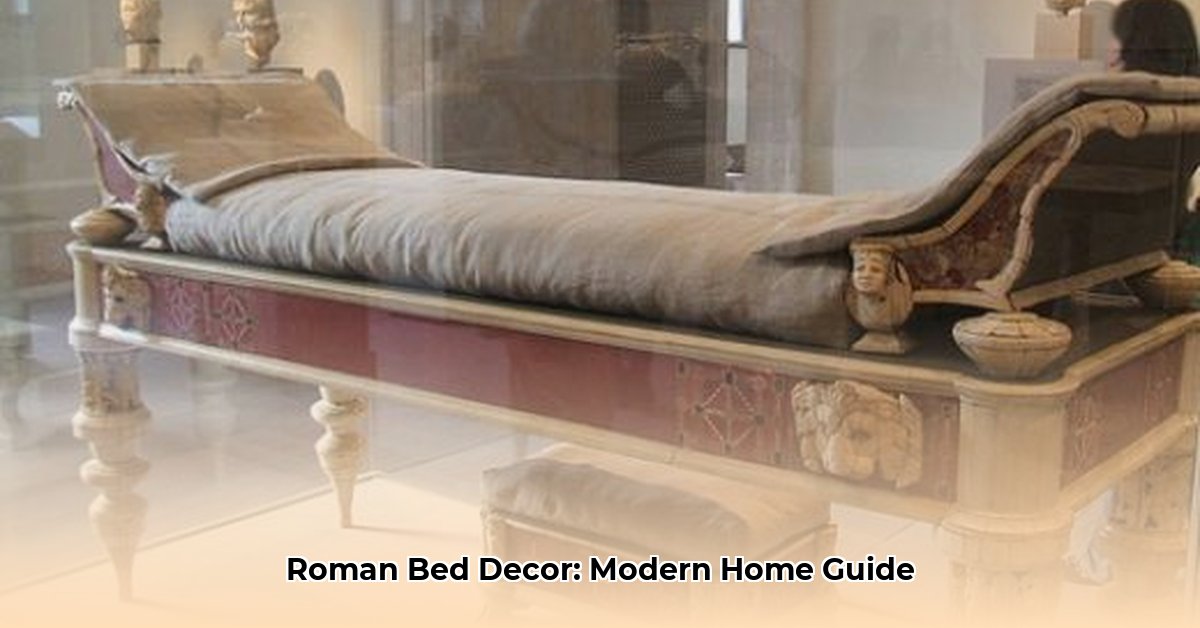Ever wondered what it was really like to sleep like a Roman? Forget those dusty museum displays; we’re diving headfirst into the surprisingly sophisticated world of ancient Roman beds. From humble straw pallets to the ridiculously opulent sleeping arrangements of emperors, we’ll uncover how these essential pieces of ancient Roman furniture reflected Roman life, their obsession with status, and their surprisingly clever design ideas. See more on Roman furniture styles. Consider this your personal blueprint for bringing a touch of Roman elegance and comfort into your own home, without feeling like you’re living in a museum. Get ready to explore the materials Romans used, the design principles to embrace, and the timeless aesthetic tricks that still powerfully influence modern interior design.
The Multifaceted World of Roman Beds: Beyond Mere Slumber
In ancient Rome, the bed, or lectus (plural: lecti), was far more than just a place to sleep. These central pieces of historical decor were integral to daily life, serving diverse functions that underscore the Romans’ innovative approach to living space. From the utterly simple to the extraordinarily elaborate, lecti were vivid reflections of an individual’s status, wealth, and lifestyle.
The Romans, while not minimalists, certainly appreciated well-designed spaces that maximized utility. Their beds came in numerous forms, each meticulously designed for a specific purpose within the household. You would rarely find the same bed in a plebeian’s humble dwelling as in a senator’s sprawling villa.
- Lectus Simplex: At the most basic end, the lectus simplex was a simple, sturdy bed, typically crafted from local woods like oak, maple, or cedar, and featuring a modest mattress. Often, these were little more than a masonry shelf built along a wall, topped with a pallet.
- Lectus Tricliniaris: This specialized dining couch, a cornerstone of Roman social life, was designed for reclining during meals and banquets. It typically accommodated three people, arranged around a low central table for easy access to food and drink.
- Lectus Cubicularis: This was the traditional Roman sleeping bed, found in the cubiculum (bedroom). These beds could range from basic wooden frames to highly adorned pieces, reflecting the owner’s means.
- Lectus Lucubratorius: A bed specifically used for study and contemplation during daytime hours, providing a comfortable spot for reading or writing.
- Lectus Diurnalis: A dedicated daybed, often crescent-shaped, designed purely for relaxation and intimate conversation.
- Lectus Funebris: A bier used ceremonially to display the body of the deceased during funeral rites, highlighting the bed’s solemn role in Roman life.
- Lectus Genialis: A double bed specifically associated with marriage, symbolizing union and fertility.
This remarkable variety underscores the Romans’ adaptability and reinforces that their beds were not merely for slumber; they were powerful design statements and versatile furniture.
Material Matters: The Fabric of Roman Comfort and Grandeur
When it came to materials, Romans possessed a diverse and often opulent palette. In more humble homes, beds were likely constructed from readily available local woods. However, true luxury was expressed through much grander, imported materials, meticulously worked into intricate designs:
- Ivory: Often inlaid into carved wooden frames or forming decorative plaques.
- Bronze: Used for frames, feet, and decorative fittings, sometimes nielloed with silver and gold.
- Silver: Rare and extremely luxurious, with frames made of solid silver known to exist among the ultra-wealthy, like Trimalchio’s in Petronius’s Satyricon.
- Tortoise-shell: Frequently used for decorative inlay work, adding a unique shimmer and texture.
- Exotic Woods: Precious woods with undulating grains, like citrus or terebinth, polished to reflect various colors, were highly prized (lecti pavonini).
These choices were rarely purely aesthetic; opulent materials served as loud declarations of status, allowing wealthy Romans to proudly display their affluence. The use of such lavish materials in beds dates back centuries, showcasing a timeless pursuit of elegant interiors.
More Than Just Sleep: The Many Lives of a Roman Bed
In contemporary society, beds are almost exclusively associated with sleeping. However, in ancient Rome, beds were remarkably versatile pieces of furniture integral to daily life, showcasing remarkable functional design. Beyond providing a place to rest, they served other significant functions:
- Dining: The lectus tricliniaris was explicitly designed for reclining during meals. This practice wasn’t just about comfort; it was deeply intertwined with socializing, feasting, and the elegant display of wealth, reflecting a sophisticated blend of leisure and social interaction.
- Socializing: Daybeds and dining couches were central to Roman social gatherings, fostering intimate conversation and a relaxed atmosphere.
- Medical Care: Roman medical texts prescribed bed rest as fundamental to patient recovery, with some beds featuring adjustable frames or specialized headrests for various ailments, demonstrating a remarkably advanced understanding of ergonomic support for healing.
- Funerals: As mentioned, beds held a solemn role in funerary rites, where the deceased might be ceremonially displayed before burial or cremation.
Status Symbol: How Your Bed Broadcast Your Wealth
In Roman society, wealth was paramount, and your bed was an undeniable way to broadcast it to the world. Lavish beds, adorned with exotic materials, intricate carvings, and precious metals, spoke volumes about the owner’s high social standing. The Romans masterfully understood the art of visual communication through their possessions. The finer the bed, the higher the status—it was a simple, yet profound, equation. The sella curulis, a ceremonial chair reserved for high-ranking magistrates, similarly underscored how furniture served as a powerful symbol of authority and prestige, parallel to the grandest lecti.
Comfort vs. Showing Off: The Roman Balance
There’s an ongoing scholarly debate about whether comfort or luxury held greater priority for Romans when selecting a bed. Some experts argue that aesthetics often trumped comfort, particularly among the elite, citing observations by authors like Juvenal who implied comfort might be secondary to lavish display. Conversely, ancient evidence points to Romans using superior mattress fillings. Pliny the Elder, for instance, described various kinds of mattresses, from simple straw and reeds for the poor to luxurious wool (from Leuconian flocks) and even swan’s down for the wealthy. Beds were also supplied with bolsters (culcita or cervical) and multiple coverings (stragulum to lie on, operimentum to pull over, and a lodix or multi-colored damask quilt polymitum as a counterpane). The truth likely lies somewhere in the middle: Romans sought an optimal balance between comfort and display, even if their definition of “comfort” differed from our modern expectations of springs and memory foam.
Ancient Craftsmanship: Unearthing the Secrets of Roman Bed Construction
Roman beds weren’t merely for sleeping; they were profound statements of wealth, status, and even innovation, constructed with techniques that showcase remarkable traditional craftsmanship. So, how were Roman beds made? Let’s delve into the fascinating details of these ancient furnishings.
The Anatomy of a Roman Bed Frame
Imagine stepping back in time into a Roman bedroom (cubiculum). The undeniable centerpiece would be the lectus. Its construction varied greatly depending on the owner’s social class, showcasing the vast economic disparities of the time.
- For the Elite: Picture beds meticulously crafted from expensive, often imported, woods such as oak, maple, citrus, or terebinth. Many grand beds were cast in durable bronze, sometimes with legs ending in ornate lion’s claws or featuring detailed animal-head fittings. These luxury pieces were frequently adorned with intricate carvings and lavish inlays of ivory, tortoise-shell, or precious metals like silver and gold, proudly showcasing the owner’s undeniable affluence. Archaeological finds, such as the bronze ‘mermaid bed’ discovered near Kozani, Greece, dating to the first century B.C., vividly illustrate these elaborate designs, featuring detailed depictions of mermaids and birds.
- For the Common Folk: Simpler beds made from readily available local wood were common. In many cases, particularly in the multi-story insulae (apartment buildings) where poorer families lived, the “bed” might be a raised support built directly from the floor, often a parallelepiped of brick and plastered bricks, on which a simple mattress was placed. For the majority of the population, functionality consistently trumped aesthetics.
The frames themselves often consisted of a basic structure on which interwoven strips of webbing or thongs were stretched, acting as rudimentary springs. These “corded beds” provided the foundational support for the mattress.
Mattress Matters: From Straw to Swansdown
What about comfort in ancient Roman beds? That, too, depended heavily on one’s financial standing and access to materials.
- Luxurious Comfort: Wealthy Romans luxuriated on thick mattresses (torus) and bolsters (culcita or cervical) generously filled with soft wool, fine feathers, or even premium swansdown. These fillings provided a remarkably comfortable and supportive sleeping surface, a testament to their pursuit of ease. A mattress padded with leaves was even found in Herculaneum, possibly for an antiparasitic action. Layers of coverings, including a soft spread (stragulum) and a covering sheet (operimentum), topped the mattress.
- Basic Necessities: The less fortunate often made do with straw or reed-filled mattresses, which were significantly less comfortable but adequately served their basic needs. In the poorest homes, bedding might consist simply of two animal skins, one for resting and one for covering.
Beyond the Bed: Completing the Cubiculum
The Roman bedroom, or cubiculum (meaning sleeping chamber), wasn’t solely about the bed. It typically included other essential furniture pieces, emphasizing a minimalist yet highly functional approach to classical interior design.
- Storage Solutions: A chest (arca), often bound with iron and ornamented with bronze hinges and locks, provided vital storage for clothing, linens, and valuables. Wealthier homes might have armaria (wooden cabinets, sometimes with shelves), used for storing religious items, personal belongings, or important documents.
- Seating Arrangements: Occasionally, a simple stool (sella) or a more comfortable chair (cathedra with a curved back) would be included for additional seating, providing a spot for contemplation or dressing.
- Lighting: Lamps (lucernae) made of terracotta or bronze provided dim lighting, often placed on specialized tables (monopodia) or suspended from the ceiling.
Archaeological discoveries continually shed light on specifics. The unearthing of a 2,000-year-old oak funerary bed in London in February 2024, complete with carved feet and wooden peg joints, offers unparalleled insight into Roman bed construction in Britain. Similarly, the remains of a burnt bed at Pompeii in 2023, with carbonized fragments of textile bedclothes and mattress filling, provide a poignant glimpse into the fleeting nature of comfort and the dramatic end of Roman life under Vesuvius.
Cleanliness and Hygiene in Ancient Times
Did the Romans prioritize cleanliness? Absolutely! They demonstrated a clear understanding of the importance of hygiene, even when it came to their beds. Regular airing of bedding was a common practice, helping to keep it fresh, dry, and free of unpleasant odors. They even employed specific tools and techniques to remove bedbugs and other pests, a necessary yet unpleasant practice to maintain a hygienic living environment.
Regional Flair: Adapting to Empire-Wide Climates
The vast Roman Empire encompassed incredibly diverse climates and cultures. This geographical spread, naturally, influenced bed construction and bedroom appointments. In colder climates, thicker blankets and insulating fur rugs provided crucial warmth, adapting to environmental necessities. In warmer regions, simpler beds with fewer coverings reflected a practical response to prevailing temperatures. This remarkable adaptation demonstrates the Romans’ resourcefulness and deep practicality in their material culture. By understanding how Roman beds were made, we gain valuable insights into Roman society, their core values, and their enduring resourcefulness.
Recreating Roman Elegance: A Step-by-Step Decor Guide for Modern Homes
Roman beds and furniture were more than just exquisite pieces; they were potent symbols of wealth and social status, serving as crucial venues for family interaction and entertainment, deeply strengthening familial bonds within Roman households. This underscores their central role in the domestic and social fabric of Roman life.
How can we seamlessly bring these ancient concepts into our contemporary homes? Here’s a lectus-inspired guide to infuse your space with timeless Roman elegance, almost certainly transforming your bedroom into a serene, historically-inspired sanctuary.
Recreate Roman Bed Design – Step-by-Step System for Your Modern Home
- Choose Your Frame: Opt for a low-profile wooden frame, mirroring the foundational simplicity and grounded elegance of Roman beds. Consider a modern platform bed for a contemporary twist that maintains the desired aesthetic. For a touch of classical grandeur, seek a frame with subtle carving details on the legs or a bronze-finished accent.
- Select Natural Materials: Prioritize a mattress made from natural, breathable materials like wool, linen, or even latex. These choices provide superior comfort and breathability, aligning with ancient Roman preferences for organic elements while offering modern ergonomic support.
- Layer Bedding Thoughtfully: Incorporate layers of soft wool blankets and crisp linen sheets. This layering not only adds visual texture and inviting warmth but also evokes the refined comfort enjoyed by wealthy Romans. For added richness, include a decorative counterpane or throw in rich, deep colors or with subtle geometric patterns reminiscent of Roman mosaics.
- Incorporate Textural Opulence: Integrate a faux fur rug at the foot of the bed or as an accent piece, especially for cooler climates. This subtly evokes the luxury and warmth of ancient Roman times without the ethical concerns of real fur. Alternatively, consider a plush wool rug with a classical border pattern.
- Embrace Timeless Simplicity: Resist the urge for excessive, cluttered ornamentation. Focus intently on clean lines, balanced proportions, and the inherent beauty of natural materials. Adhere to the Roman principle of understated elegance, where quality and craftsmanship speak louder than quantity.
- Add a Daybed Element: Introduce a small, elegant bench, a chaise lounge, or a set of comfortable cushions on a low platform near the main bed. This creates a dedicated lounging area, reminiscent of the lectus diurnalis or lectus lucubratorius, perfect for reading, relaxation, or quiet conversation. Look for pieces with simple, sturdy wooden frames.
- Finalize Your Room with Roman Touches: Complete the transformation by selecting wall art and sculptures that feature classical Roman motifs and figures, such as busts or relief carvings. Strategic placement of these elements can significantly elevate the room’s Roman aesthetic. Consider adding a simple wooden chest (arca) at the foot of the bed for storage, or a small marble-topped side table (monopodium) for a lamp or personal items. Maximize natural light with minimal window treatments, and incorporate earthy wall tones like terracotta, beige, or soft grays.
Recreating Roman Aesthetic in Your Modern Home: Guiding Principles
Want to capture the authentic essence of Roman design elements in your room beyond just the bed? Here’s how to ensure a cohesive and stylish outcome:
- Simplicity & Purpose: Embrace the mantra that “less is often more.” Romans highly valued functionality and understated elegance over excessive, cluttered decoration. Every piece served a purpose or conveyed status.
- Neutral Palette with Strategic Accents: Gravitate towards an earthy and calming color scheme, utilizing sophisticated tones like beige, cream, terracotta, burnt orange, and soft grays. Introduce bold accents through textiles or select decorative items, reflecting the vibrant frescoes found in Pompeian homes.
- Natural Light & Openness: Maximize the influx of natural light into your space. Roman homes were designed to be bright and airy, with atriums and peristyles allowing light and air to flow freely. Prioritize open layouts where possible.
- Textural Elements: Integrate a rich variety of textured fabrics (linen, wool, silk), warm woods, and cool stone finishes (marble, travertine) for floors or accents. These elements add crucial depth and interest to the design without relying on overt patterns.
- Symmetry & Balance: Create a powerful sense of balance and order by thoughtfully arranging furniture and decor symmetrically. This classical approach brings tranquility and visual harmony, echoing the architectural principles of Roman buildings.
- Sculptural Accents & Greenery: Incorporate busts, small statues, or classical pottery. Introduce lush indoor plants to mimic the courtyard gardens (peristylium) of Roman villas, connecting your space to nature.
Pros and Cons of Roman-Inspired Beds & Decor
| Feature | Pros | Cons |
|---|---|---|
| Design Appeal | Timeless and elegant, offering enduring sophistication. | May not suit all diverse modern decor styles (e.g., industrial, bohemian). |
| Material Focus | Strong emphasis on natural, durable, and often sustainable materials (wood, wool, linen, stone). | Can be more expensive to source and replicate authentic materials than synthetic alternatives. |
| Atmosphere | Promotes a powerful sense of calm, order, and serene peace, conducive to rest and relaxation. | Requires careful curation to avoid blandness or appearing overly minimalist if not balanced with texture/accents. |
| Comfort | High-quality natural bedding materials (wool, linen, down) offer superior breathability and comfort. | Historically, comfort was a secondary consideration to status for some, which might influence strict replication. |
| Adaptability | Elements can be easily integrated into various existing decor styles, from traditional to contemporary. | Limited traditional color palette might feel restrictive to some individuals desiring vibrant, diverse hues. |
| Historical Depth | Connects your home to millennia of rich history and cultural significance. | Requires more effort and research to source truly authentic-looking pieces or understand the underlying philosophy. |
Final Thoughts: Future-Proofing Your Home with Roman Decor
Exploring ancient Roman beds offers far more than a mere glimpse into historical furniture; it provides deep insights into Roman society’s values and priorities. It’s not simply about replicating a historical piece of furniture. It’s fundamentally about embracing a powerful philosophy of simplicity, functionality, and a profound connection to nature. This blend of grandeur and thoughtful design makes Roman aesthetics remarkably adaptable for modern homes, ensuring your space remains stylish and relevant for years to come.
By judiciously selecting elements like subtly grand beds, elegant natural materials, and classical accents, you can create a home that is both a serene sanctuary and a celebration of timeless design principles. So, why not bring a touch of that enduring ancient Roman style and sophistication into your own modern home?










